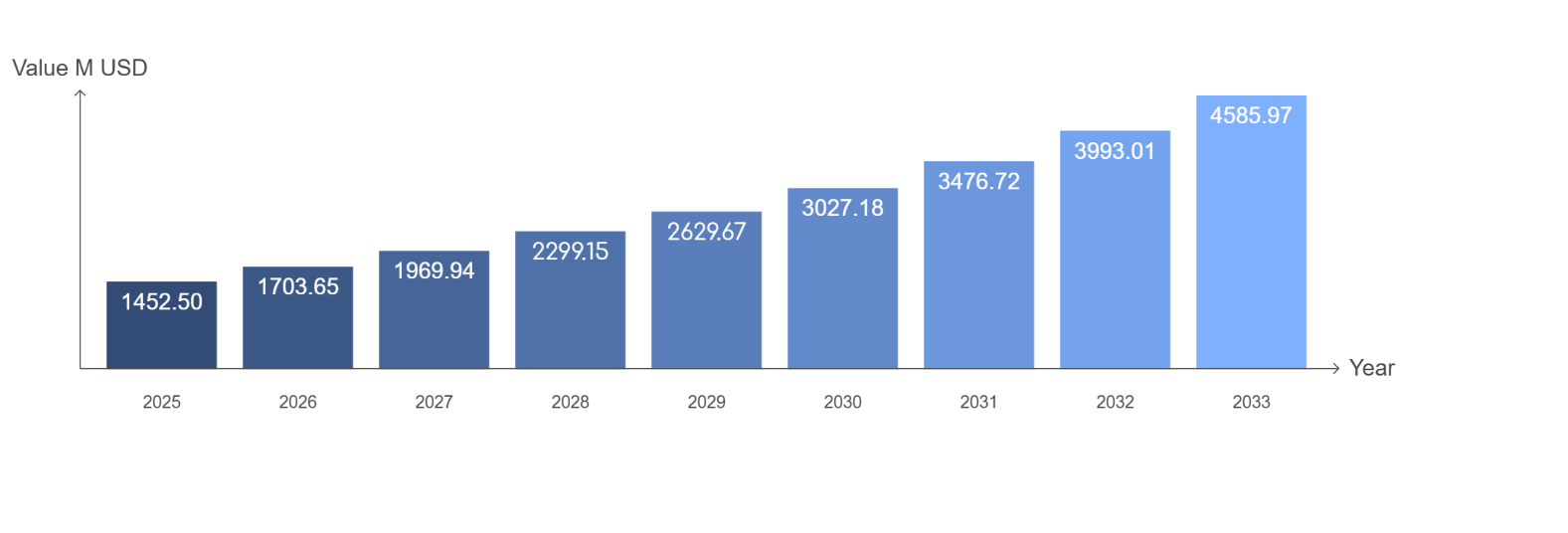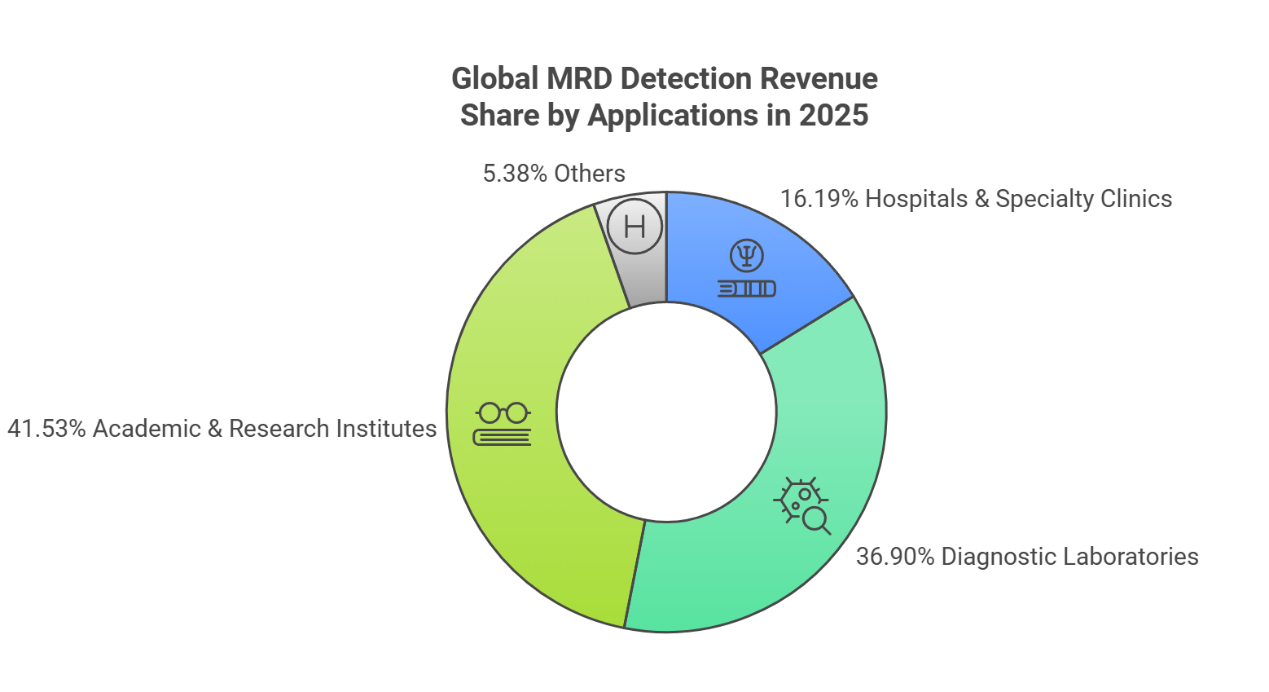1. Global MRD Detection Market Size and Market Definition
MRD (Minimal Residual Disease) refers to the state of a small amount of tumor cells remaining in the body after treatment of malignant tumors, which is the root cause of tumor recurrence. MRD Detection is a sensitive diagnostic method used to detect trace amounts of cancer cells remaining in patients after treatment. Accurate MRD detection is the basis for personalized precision medicine for patients.
Global MRD Detection Market Size from 2025 to 2033 exhibits a robust expansion, with the market value increasing from $1.453 billion in 2025 to an estimated $4.585 billion by 2033. This significant growth suggests a substantial increase in the adoption of MRD detection technologies and a burgeoning market driven by advancements in medical diagnostics and the precision medicine sector.
Figure Global MRD Detection Value (M USD) and Growth Rate from 2025-2033

2. MRD Detection Market Drivers Factors
‘Necessity and Importance of MRD Detection’
MRD refers to the presence of residual cancer cells in the body during or after treatment, even after tumors become undetectable in imaging or clinical exams. If these cells remain in the body, they can cause local or metastatic relapse. In blood cancers, MRD can be used to evaluate treatment efficacy and predict relapse; in solid tumor cancers, it can help identify whether a patient is at high or low risk of relapse. MRD is a biomarker, a positive result is: tumor patients can still be detected after treatment The presence of minimal residual disease indicates a high risk of recurrence; a negative result is that no minimal residual disease is detected in tumor patients after treatment, indicating a low risk of recurrence. Therefore, MRD Detection has good prognostic value in hematological tumors and various solid tumors such as lung cancer, colorectal cancer, breast cancer, and esophageal cancer. The value of MRD Detection will drive the growth of the MRD Detection market.
‘Increased demand for personalized medicine’
Many researchers and cancer centers have begun to adopt a personalized approach to cancer care, and oncology has entered the era of personalized customized precision treatment. MRD Detection is the basis of personalized precision medicine for patients. It can predict clinical outcomes and stratify the risk of patients’ conditions, guide treatment decisions, and predict tumor recurrence early. It has high clinical application value and commercialization prospects. With the increase in medical expenditure, the patient’s demand for customized and personalized medicine will drive the MRD Detection market.
3. Global MRD Detection Revenue and Share by Type (2020-2025)
Global MRD Detection market has been segmented into three primary types: Flow Cytometer, Polymerase Chain Reaction (PCR), and Next Generation Sequencing (NGS).
From 2020 to 2025, these technologies have shown a significant growth in revenue, reflecting the expanding demand for advanced MRD detection methods. Flow Cytometer, leading with the highest market share, has seen its revenue decrease slightly from 39.48% in 2020 to 32.37% in 2025, indicating a gradual shift towards other technologies. PCR has maintained a stable market share, starting at 43.88% in 2020 and expected to drop slightly to 38.65% by 2025. NGS, however, has shown the most promising growth, with its market share increasing from 16.65% in 2020 to a projected 28.98% by 2025, demonstrating the rapid adoption of this technology in the field of MRD detection. This growth is attributed to the increasing preference for NGS due to its scalability and sensitivity, allowing for the detection of one cancer cell in a group of 1 million healthy cells, which is particularly beneficial in monitoring minimal residual disease in cancer patients. The collective revenue from these three types is expected to rise substantially, from $628.23 million in 2020 to a projected $1,452.50 million by 2025, showcasing the robust expansion of the MRD Detection market.
Table Global MRD Detection Revenue (M USD) by Types (2020-2025)
| 2020 | 2021 | 2022 | 2023 | 2024 | 2025 |
Flow Cytometer | 247.99 | 277.16 | 319.97 | 367.01 | 415.15 | 470.17 |
Polymerase Chain Reaction (PCR) | 275.64 | 317.28 | 370.70 | 429.17 | 490.52 | 561.39 |
Next Generation Sequencing (NGS) | 104.60 | 127.79 | 175.44 | 245.53 | 326.86 | 420.93 |
Total | 628.23 | 722.23 | 866.11 | 1041.72 | 1232.53 | 1452.50 |
Table Global MRD Detection Revenue Share by Types (2020-2025)
| 2020 | 2021 | 2022 | 2023 | 2024 | 2025 |
Flow Cytometer | 39.48% | 38.38% | 36.94% | 35.23% | 33.68% | 32.37% |
Polymerase Chain Reaction (PCR) | 43.88% | 43.93% | 42.80% | 41.20% | 39.80% | 38.65% |
Next Generation Sequencing (NGS) | 16.65% | 17.69% | 20.26% | 23.57% | 26.52% | 28.98% |
Total | 100.00% | 100.00% | 100.00% | 100.00% | 100.00% | 100.00% |
4. Global MRD Detection Revenue and Share by Application (2020-2025)
Global MRD Detection market has been segmented by applications into Hospitals & Specialty Clinics, Diagnostic Laboratories, Academic & Research Institutes and Others. Over the period from 2020 to 2025, these applications have demonstrated a notable increase in revenue, reflecting the growing demand for MRD detection across various sectors of the healthcare industry.
Hospitals & Specialty Clinics have seen their revenue increase from $81.85 million in 2020 to a projected $235.17 million in 2025, demonstrating a significant uptake in MRD detection technologies in direct patient care settings.
Diagnostic Laboratories have also shown a robust increase, with revenue growing from $183.59 million in 2020 to an expected $535.99 million in 2025, highlighting the critical role of diagnostic services in the MRD Detection market.
Academic & Research Institutes contribute the most substantial share, with revenue rising from $326.06 million in 2020 to a projected $603.20 million in 2025, reflecting the substantial investment in research and development within the MRD Detection field.
Lastly, Others category, although smaller, also exhibits growth, from $36.73 million in 2020 to an estimated $78.14 million in 2025
In summary, the MRD Detection market’s revenue across applications has shown a consistent upward trend, indicating the expanding importance of MRD detection in healthcare and research.
Table Global MRD Detection Revenue (M USD) by Applications (2020-2025)
| 2020 | 2021 | 2022 | 2023 | 2024 | 2025 |
Hospitals & Specialty Clinics | 81.85 | 98.46 | 126.56 | 156.13 | 190.94 | 235.17 |
Diagnostic Laboratories | 183.59 | 221.33 | 280.98 | 353.33 | 434.42 | 535.99 |
Academic & Research Institutes | 326.06 | 360.50 | 408.91 | 474.39 | 539.38 | 603.20 |
Others | 36.73 | 41.95 | 49.66 | 57.85 | 67.80 | 78.14 |
Total | 628.23 | 722.23 | 866.11 | 1041.72 | 1232.53 | 1452.50 |
Figure Global MRD Detection Revenue Share by Applications in 2025

5. Global MRD Detection Market Size (Revenue) Comparison by Region
Global MRD Detection market revenue by region from 2020 to 2025 showcases a robust growth trajectory across all major regions. North America, with the United States at the forefront, has been a significant contributor to the market, driven by advanced healthcare infrastructure and a focus on innovative diagnostic technologies. The region’s revenue is expected to increase from $327.22 million in 2020 to a projected $750.30 million by 2025. Europe follows closely, with a strong presence in countries like Germany, the UK, and France, and is anticipated to grow from $175.49 million in 2020 to $387.88 million by 2025. The Asia-Pacific region, led by China, Japan, and India, is set to experience rapid growth, moving from $107.84 million in 2020 to an estimated $275.39 million by 2025. Latin America and the Middle East & Africa, while starting from a smaller base, are also expected to contribute to the market’s expansion, with revenues projected to grow from $10.05 million and $7.64 million in 2020 to $21.79 million and $17.14 million by 2025, respectively. This overall growth is indicative of the increasing global demand for MRD Detection technologies and the impact of regional healthcare developments on market dynamics.
Table Global MRD Detection Revenue (M USD) by Region (2020-2025)
| 2020 | 2021 | 2022 | 2023 | 2024 | 2025 |
North America | 327.22 | 374.31 | 448.19 | 541.50 | 638.85 | 750.30 |
Europe | 175.49 | 200.89 | 239.79 | 281.03 | 331.70 | 387.88 |
Asia Pacific | 107.84 | 126.90 | 154.15 | 190.60 | 228.77 | 275.39 |
Latin America | 10.05 | 11.26 | 13.38 | 16.08 | 18.88 | 21.79 |
Middle East & Africa | 7.64 | 8.87 | 10.60 | 12.51 | 14.34 | 17.14 |
Total | 628.23 | 722.23 | 866.11 | 1041.72 | 1232.53 | 1452.50 |
6. Global MRD Detection Market Competitive Landscape
The top 6 companies in the global MRD Detection market have shown considerable revenue growth from 2020 to 2025, indicating their significant contributions to the industry. Roche has maintained a leading position, with revenues increasing from $99.65 million in 2020 to a projected $198.09 million by 2025. Natera follows with a substantial growth, expanding from $41.12 million in 2020 to an expected $204.36 million by 2025. Adaptive Biotechnologies also demonstrates a strong upward trend, with revenues rising from $39.36 million in 2020 to a forecasted $125.31 million by 2025. Bio-Rad Laboratories contributes significantly to the market, with revenues growing from $55.31 million in 2020 to a projected $97.60 million by 2025. GuardantHealth rounds out the top five, with revenues increasing from $24.09 million in 2020 to an anticipated $99.57 million by 2025. Labcorp revenue will reach $69.79 million in 2025. These figures underscore the competitive landscape of the MRD Detection market and the expanding role of these key players in shaping the industry’s future.
Table Global MRD Detection Revenue (M USD) by Manufacturer (2020-2025)
| 2020 | 2021 | 2022 | 2023 | 2024 | 2025 |
Roche | 99.65 | 113.27 | 132.40 | 154.35 | 175.68 | 198.09 |
Natera | 41.12 | 53.28 | 72.58 | 102.02 | 156.26 | 204.36 |
Adaptive Biotechnologies | 39.36 | 45.25 | 66.21 | 87.14 | 103.55 | 125.31 |
Bio-Rad Laboratories | 55.31 | 61.57 | 67.47 | 76.85 | 86.98 | 97.60 |
GuardantHealth | 24.09 | 33.00 | 49.59 | 64.54 | 80.77 | 99.57 |
32.32 | 35.74 | 41.40 | 52.41 | 60.78 | 69.79 |
Figure Global Top 6 Players Market Share by Revenue






